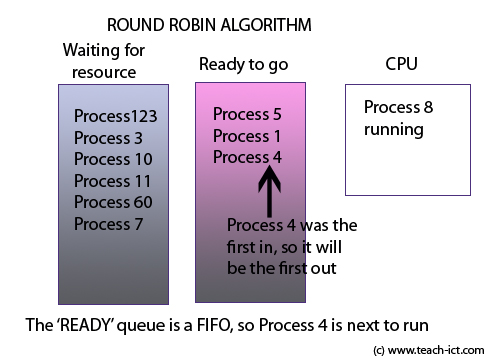 A LEVEL COMPUTING
A LEVEL COMPUTING Scheduling
Scheduling
 Theory
Theory
(This is the older material - click here - for current specification content)
6. Scheduling algorithms (1)
As mentioned earlier, a good scheduler is trying to be as efficient and fair as possible. But there are many ways of doing this. These are called 'scheduling algorithms'.
An 'algorithm' is the set of steps and decisions coded as software instructions.
Round Robin or 'Time Slice'
This approach makes use of a special form of queue called a FIFO, meaning 'First in First Out' as shown below

This is quite a fair approach - the process that has been waiting the longest gets the next turn.

The process is allowed to run for a fixed amount of CPU time then it goes to the back of the queue once again. This is a good algorithm if every job is more or less equally important. The downside of the Round Robin approach is that it takes no account of job priority.
For example process 1 sitting just behind (Round Robin) top priority Process 4 might be dependent on reacting to some timed event such as data logging and yet it is made to wait its turn. So for urgent jobs, Round Robin is not the best way to go. It does have the advantage of being very simple to implement.
Challenge see if you can find out one extra fact on this topic that we haven't already told you
Click on this link: Round Robin Scheduling
Copyright © www.teach-ict.com

